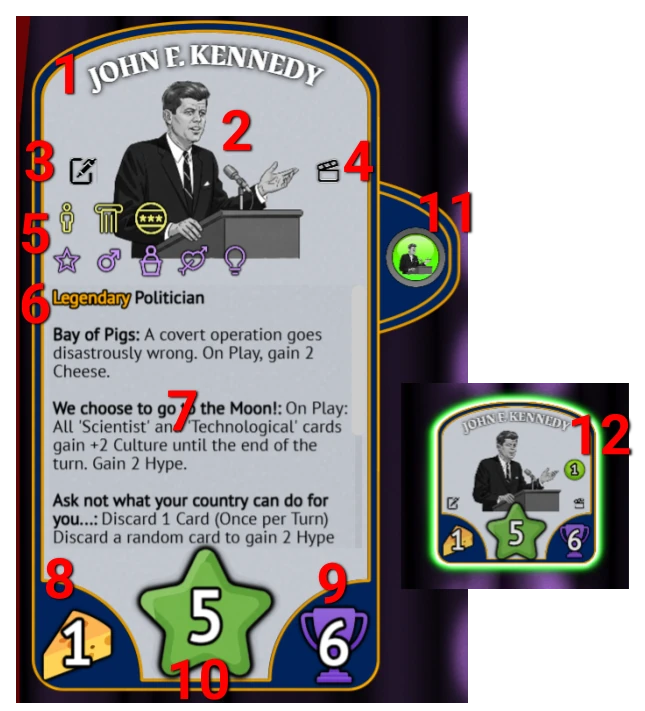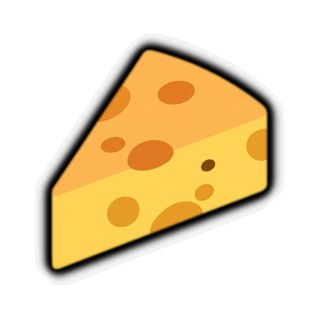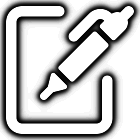Cards
Cards are the heart of The Scene, representing the vast universe of pop culture characters, real-life personalities, and groups you can recruit for your scene.
Card Anatomy

There are two representations of a card in The Scene. There is the card itself, which appears in your hand and in the board’s lane areas, and the card info panel, which displays detailed information about the currently selected card. This area is used for Obstacle details, as well.
Each card has several key properties that define its function and feel:
- Name: Identifies the card.
- Portrait: A graphical depiction of the person (or entity) represented by the card.
- Writer Slot: An icon that appears if a writing portrayal is able to be played on this card.
- Actor Slot: An icon that appears if an acting portrayal is able to be played on this card.
- Descriptors: Tags & archetypes that define a card’s traits (e.g.
 Actor,
Actor,  Fictional,
Fictional,
 Science Fiction,
Science Fiction,  Professional (Law Enforcement)). These are crucial for synergies and for how Adversaries react to your cards. Liked descriptors will be shown in green, while Disliked descriptors will
appear in red. You can see a comprehensive listing of all Tags and Archetypes on the Descriptors reference page.
Professional (Law Enforcement)). These are crucial for synergies and for how Adversaries react to your cards. Liked descriptors will be shown in green, while Disliked descriptors will
appear in red. You can see a comprehensive listing of all Tags and Archetypes on the Descriptors reference page. - Short Description: This includes both the card’s Rarity (Common , Uncommon , Rare , Legendary ) and the primary feature of the card as derived from its tags and archetypes. Rarity determines how often a card appears and generally correlates with its mechanical complexity and power.
- Abilities: The unique effects the card can perform. These are what make each card special. Most abilities trigger automatically, but some are Activated manually.
 Cheese: The base
Cheese: The base  Cheese value the card contributes when it scores.
Cheese value the card contributes when it scores. Culture: The base
Culture: The base  Culture value the card contributes when it score
Culture value the card contributes when it score- Cost: The amount of
 Hype required to play the card from your hand.
Hype required to play the card from your hand. - Activated Ability Button: This button appears only when a selected card has an Activated ability. If the button is enabled, you can click it to use the ability.
- Activated Ability Indicator: This small icon appears if the card has an Activated ability available to use. It allows you to quickly scan the game board for cards with actions you can take.
Cards also have a background color and a border color. The background color is simply cosmetic and is meant to be an abstract reflection of the person depicted on the card. It has no mechanical value. The border color matches the Rarity of the card. In this example, John F. Kennedy is Legendary , so his border is gold.
Discovering Cards and Abilities
A key part of the fun in The Scene is discovering what each character can do. When you first encounter a card, its abilities will be hidden from you.
- Reveal on Use: An ability is only revealed the first time it is triggered or activated. Until then, you’ll see a placeholder (like
???) where the ability description should be. - Persistent Discovery: Once an ability is revealed, it stays revealed forever. This knowledge persists across all your future runs, allowing you to build up your understanding of the game’s vast pop culture universe over time. You can see everything you’ve unlocked by viewing your collection from the game’s main menu.
- Easter Eggs: Some abilities are completely hidden and don’t even show a placeholder. These are rare “easter eggs” waiting to be discovered through clever play and specific interactions!
Card Types
Cards come in several varieties, each with a specific role to play.
- People: The general term for any card representing a single individual, whether a real person or a fictional character.
- Roles: Cards representing fictional characters or historical figures (e.g.
Tom Sawyer,Abraham Lincoln). These cards have special slots for attachments. - Actors & Writers: Cards with the
 Actor or
Actor or  Writer archetypes can be attached to Role cards to create a Portrayal.
Writer archetypes can be attached to Role cards to create a Portrayal. - Groups: Cards with the
 Group Group archetype represent a collective (e.g., a band, a comedy troupe). They cannot participate in portrayals.
Group Group archetype represent a collective (e.g., a band, a comedy troupe). They cannot participate in portrayals. - Crew: Cards with the
 Crew archetype can be played to a separate Crew Area instead of the main board. They provide powerful, persistent effects that can define your strategy for the entire run.
Crew archetype can be played to a separate Crew Area instead of the main board. They provide powerful, persistent effects that can define your strategy for the entire run.
Portrayals: Bringing Roles to Life
A key mechanic in The Scene is attaching Actor and Writer cards to Role cards. This creates a Portrayal, which modifies the Role’s Culture and Cheese output.
- Attaching: You can play an Actor or Writer from your hand onto a Role card that is already on the board.
- Portrayal Types:
- Canonical: The actor/writer is the one who actually portrayed/wrote the role in the real world (for example if you were to play Charlie Chaplin onto The Tramp). This gives a significant 50% Culture bonus!
- Parody: The actor/writer portrayed the role in a parody setting. This gives a 25% Culture bonus, and any
 from the portrayal is ignored when scoring!
from the portrayal is ignored when scoring! - Normal: A standard casting where the talent and role share some logical descriptors. No bonus or penalty.
- Miscast: A wacky casting where the talent and role have very little in common. This incurs a 25% Culture penalty and adds +2 Cheese.
Important
Card Abilities & Statuses
- Abilities: These are the special rules on cards, defined by a trigger (like “when played” or “when this card scores”), conditions, and effects. Most are automatic, but some rare abilities can be activated by the player. Usually, when an ability triggers, you will see a speech bubble appear on the card on which it triggered.
- Status Effects: Cards can be affected by temporary or permanent statuses that change their behavior. For a full list, see the Status Effects reference page.